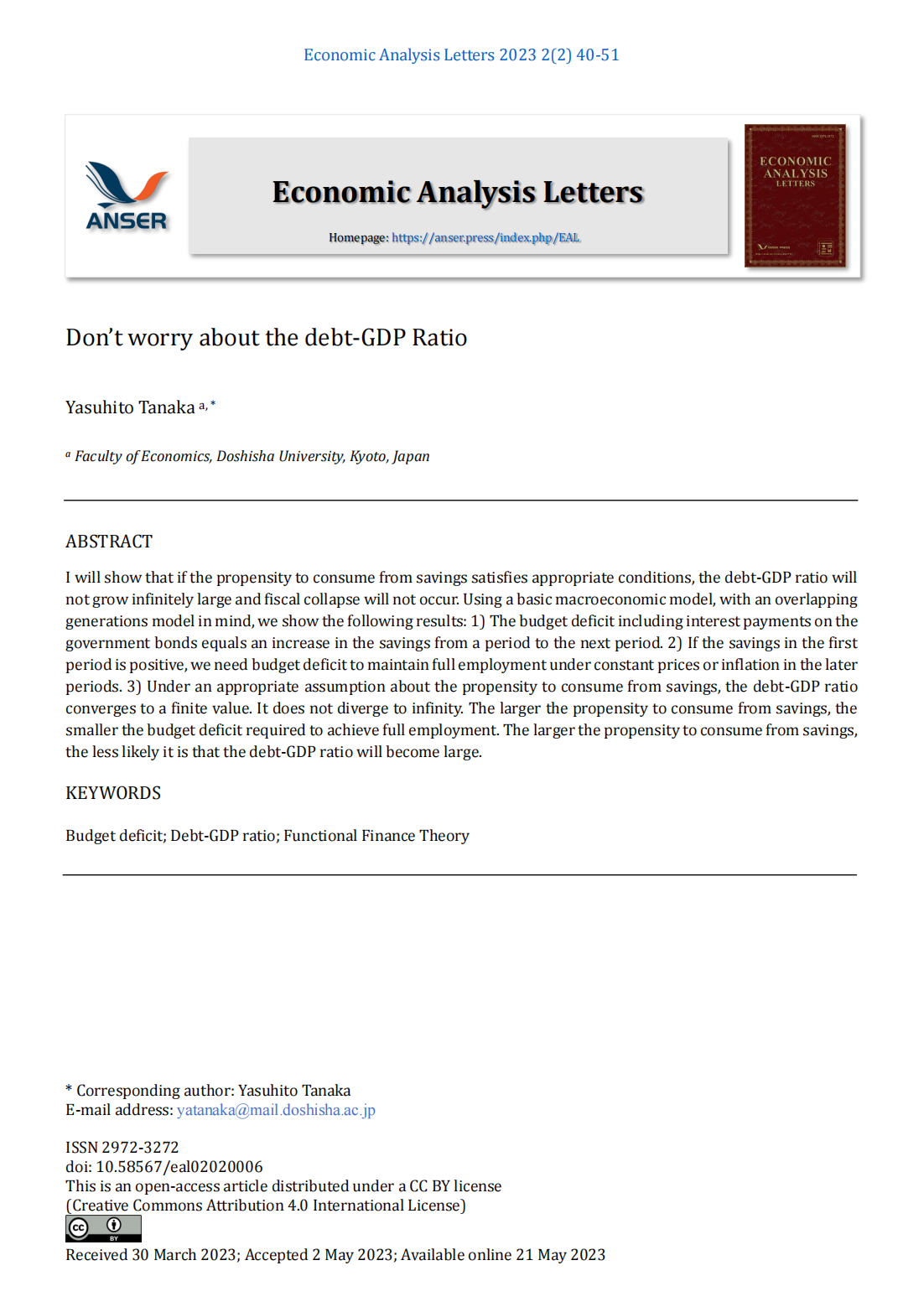Don’t worry about the debt-GDP Ratio
DOI:
https://doi.org/10.58567/eal02020006Keywords:
Budget deficit, Debt-GDP ratio, Functional Finance TheoryAbstract
I will show that if the propensity to consume from savings satisfies appropriate conditions, the debt-GDP ratio will not grow infinitely large and fiscal collapse will not occur. Using a basic macroeconomic model, with an overlapping generations model in mind, we show the following results: 1) The budget deficit including interest payments on the government bonds equals an increase in the savings from a period to the next period. 2) If the savings in the first period is positive, we need budget deficit to maintain full employment under constant prices or inflation in the later periods. 3) Under an appropriate assumption about the propensity to consume from savings, the debt-GDP ratio converges to a finite value. It does not diverge to infinity. The larger the propensity to consume from savings, the smaller the budget deficit required to achieve full employment. The larger the propensity to consume from savings, the less likely it is that the debt-GDP ratio will become large.
References
Blanchard, O., (2022), Deciding when debt becomes unsafe,International Monetary Fund. https://www.imf.org/en/Publications/fandd/issues/2022/03/Deciding-when-debt-becomes-unsafe-Blanchard#:~:text=When%20does%20the%20level%20of,to%20default%20at%20some%20point.
Domar, E. D. (1944), The Burden of Debt-and the National Income. American Economic Review, Vol.34, pp. 798-827.
Kelton, S., 2020), The Deficit Myth: Modern Monetary Theory and the Birth of the People’s Economy. Public Affairs.
Lerner, A. P. (1943), Functional Finance and the Federal Debt. Social Research, Vol.10, pp. 38-51.
Lerner, A. P. (1944), The Economics of Control: Principles of Welfare Economics. Macmillan.
Mochizuki, S., 2020), A book understanding MMT (in Japanese, MMT ga yokuwakaru hon). Shuwa System.
Morinaga, K., (2020), MMT will save Japan (in Japanese, MMT ga nihon wo sukuu). Takarajimasha.
Nakano, A., (2020), A book to understand the key points of MMT (in Japanese, MMT no pointo ga yokuwakaru hon), Shuwa System.
M. Otaki., (2007), The dynamically extended Keynesian cross and the welfare-improving fiscal policy. Economics Letters, Vol. 96:0 pp. 23–29. https://doi.org/10.1016/j.econlet.2006.12.005.
M. Otaki., (2009), A welfare economics foundation for the full-employment policy. Economics Letters, Vol. 102:0 pp. 1–3. https://doi.org/10.1016/j.econlet.2008.08.003.l
M. Otaki., (2015), Keynsian Economics and Price Theory: Re-orientation of a Theory of Monetary Economy. Springer.
Park, S., (2020), The fallacy of fiscal collapse (in Japanese, Zaisei hatanron no ayamari). Seitosha.
Shimakura, G., (2019), What is MMT? (in Japanese, MMT towa nanika), Kadokawa Shinsho.
Mitchell, W., Wray, L. R., & Watts, M., 2019), Macroeconomics. Red Globe Press.
Wray, L. R., (2015), Modern Money Theory: A Primer on Macroeconomics for Sovereign Monetary Systems (2nd ed.). Palgrave Macmillan.
Yoshino, N., & Miyamoto, H., (2020), Revisiting the public debt-stability condition: rethinking the Domar condition. ADBI Working Paper Series, No. 141, Asian Development Bank Institute. Retrieved from https://www.adb.org/sites/default/files/publication/606556/adbi-wp1141.pdf

Downloads
Published
How to Cite
Issue
Section
License
Copyright (c) 2023 Yasuhito Tanaka

This work is licensed under a Creative Commons Attribution 4.0 International License.